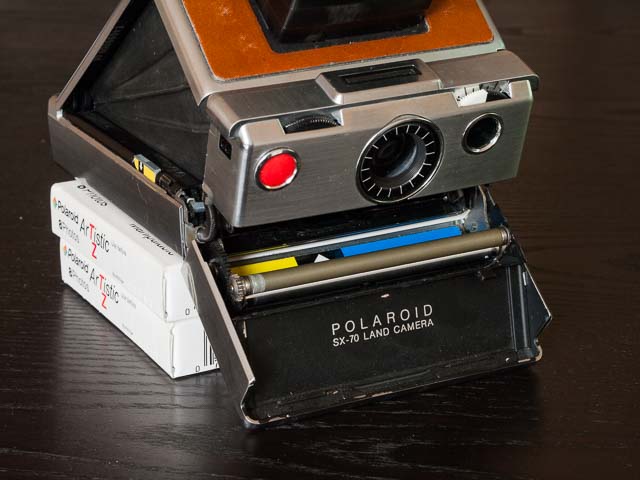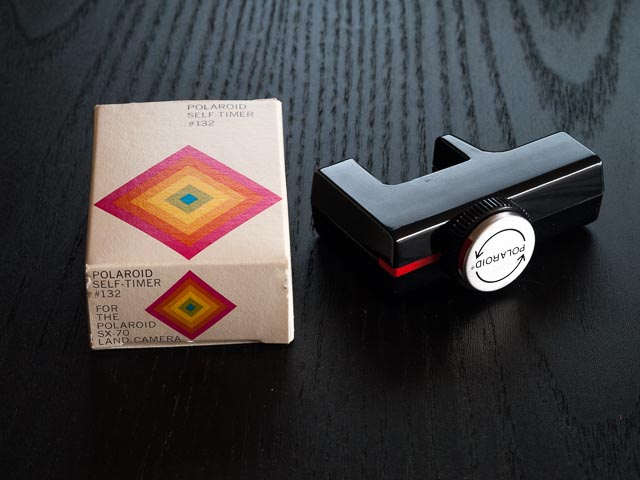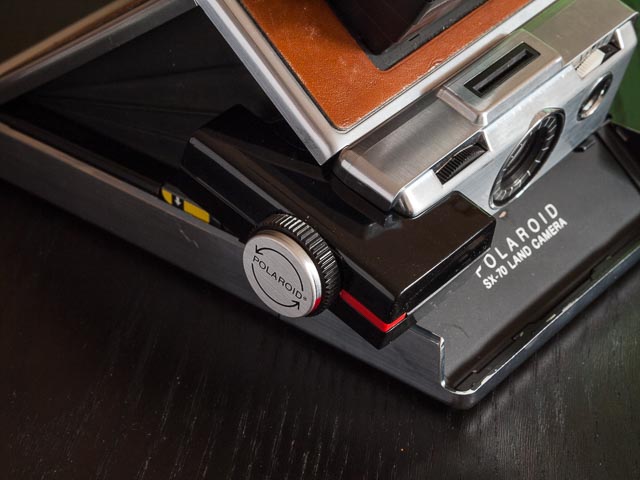Polaroid SX-70 (original model)

Edwin Land’s original vision was for a camera that would deliver a print into your hand that would develop in front of your eyes without any effort or intervention from the photographer. He launched his first camera, the Polaroid 95, in 1947. But it wasn’t until the 1972 launch of the SX-70 that technology finally caught up with Land’s vision.
SX-70 film was an amazing piece of chemical engineering, and the SX-70 camera was an equally breath-taking piece of mechanical engineering. Consider what exactly it is we have here… a Polaroid print is essentially a contact print, that is to say it is the same size and the negative. And the size of the image in an SX-70 print is 79x77mm. A typical medium format SLR produces a negative 56x56mm. That means the SX-70 SLR produces a negative around twice a big as a typical medium format SLR. Anyone who has ever used a big, bulky medium format SLR will know how amazing it is to produce a SLR that produces an image twice the size that can fold up and by carried in a large overcoat pocket!
To get an idea of the complexity of the engineering of the SX-70 camera, check out this wonderful advertising film from the early 1970s:
The SX-70 is a very simple camera to use… it uses a fully automatic exposure system (the first SLR to do so in fact), and on the front of the camera there are just two controls: a focusing wheel and the lighten/darken wheel (essentially an exposure compensation control). This means that you don’t get the same control over exposure that you would expect from a normal SLR. The SX-70 was fitted get a high quality 4 element glass 116mm f/8 lens that was capable of resolving plenty of detail (though there is quite a lot of barrel distortion).
F8 will sound extremely slow to anyone who is accustomed to a typical 35mm SLR, but as anyone who has ever used a larger format camera will know, depth-of-field gets shallower as the format gets bigger. As I have already said the SX-70 is a very large format camera indeed. This means that even at f/8 you get pretty shallow depth-of-field (in 35mm terms the lens is roughly equal to a 45mm f/2.8 lens). So if the maximum aperture was much larger than f/8 focusing would become quite difficult, particularly with close up photography, even with the SLR viewfinder of the SX-70. In fact shallow depth of field is one of the things I love about Polaroid photography!
And close-up photography is a particular talent of the SX-70 due to a couple of factors. To begin with, because you have an SLR viewfinder you get none of the parallax problems that make close-up photography so miserable on older pack-film Polaroid cameras. Secondly Polaroid make some really nice close-up accessories that only fit the manual focus SX-70 SLRs (not the later sonar auto-focus models.)
So can you still use these cameras…? Absolutely you can! Of course Polaroid stopped making film for these cameras a long time ago. The most recently produced Polaroid SX-70 film had a use by date of 2009. I still have a couple of boxes of this film (SX-70 TZ Artistic) and I shall be very sad when the last of it is gone. Being so old this film no longer produces the bright colours it originally would have done, but fortunately Polaroid SX-70 film is like fine vintage wine… it gets better as it gets older. Old SX-70 film produces beautiful greens, browns and yellows that give the prints a lovely organic feel.
And of course you can now buy brand new film for your SX-70 camera from The Impossible Project. Back in 2010 Impossible took over Polaroids integral film factory in the Netherlands and starting producing there own film. (BTW, ‘integral film’ is a general term for all Polaroid films that produce integrated self-developing prints that don’t need to be peeled apart.) For the last few years of Polaroid film production Polaroid used stock piles of raw materials. This means that the manufacture of these raw materials ended maybe 5 years or more before Impossible took over the Polaroid factories. This means that Impossible had to start from scratch to develop brand new raw materials. And this in turn means that the results produced by Impossible films are very different from those produced by Polaroid films.
Not only that, Impossible films are still in development. To some extent you are effectively acting as a beta-tester when you by Impossible film. In particular the ‘opacification layer’ which protects the image from light as it is developing isn’t very good. This means you have to protect your prints from light as soon as they are ejected from the camera… you can’t watch them develop like you could with Polaroid film. But the requirement of a pioneering attitude to use Impossible films seems to appeal very strongly to the type of person who is attracted to Polaroid photography in the first place, and Impossible of had considerable success with their films.
Polaroid SX-70 (original model) detailed photos
Here is the SX-70 folded and ready to be slipped into your pocket!
The camera is made out of plastic, but the plastic is coated with a thick and very high quality chrome plating. Indeed many people are sure the camera is made entirely out of metal.
A high quality real leather covering completes what is obviously a luxury product.

Here is the SX-70 unfolded and ready to take photographs

From the back you can see the viewfinder. It’s takes a wee bit of practice take position your eye correctly to see the whole of the viewfinder image, but once you have the knack framing and focusing your shot is a pleasure.
If you’re looking for a camera to actually use, I would heartily recommend getting a manual focus SX-70 rather than one of the later sonar auto focus models (like the Polaroid PolaSonic Autofocus featured on this website)… amazing though they are!

The underside of the original model is completely plain, though later Alpha 1 models gained a tripod bush.

When the yellow button on the side of the camera is pressed the front of the camera opens and the film pack can be loaded.

Polaroid SX-70 accessories
Polaroid SX-70 accessory kit
Polaroid produced produced this accessory kit with beautiful packaging designed by Paul Giambarba. I think even today it looks fresh and modern.

I think the box must have been designed to act as a display stand for the sales counter of the shops selling Polaroid products.

Polaroid Accessory Holder #113
The first item in the accessory kit is an accessory holder design to be used with the close-up lens and the lens shade. The holder locks into place using the flash bar slot, and there is a pass through slot so flash bars can still be used after the holder has been mounted.

Polaroid Lens Shade #120
The next item in the accessory kit is the Lens Shade which must be used with the accessory holder.

And here is the Lens shade fitted to the camera.

Polaroid Lose Up Lens And Flash Diffuser #121
And this is the close up lens, which comes with a flash diffuser to prevent over exposure when using flash for close up shots (something I have never done… I prefer to use natural light and a tripod to cope with the very long shutter speeds the SX-70 can use.)

Polaroid Remote Shutter Button #112
Useful for preventing camera shake when using you SX-70 on a tripod for close up photography.

Polaroid Tripod Mount #111
The final part of your close up kit if you have an original model SX-70 is the tripod mount which clips to the bottom of the camera to provide a tripod bush.
This device also angles the camera correctly if you just want to use a table top to support your camera (other wise the camera points down).

And here is the SX-70 all kitted out for close up photography!

Polaroid Self-timer #132
Polaroid also made this very nice mechanical self-timer so you can get yourself in the shot. This item wasn’t part of the accessory kit, but it was included with my kit.

And here is the self-timer fitted over the shutter button on the camera.

Polaroid SX-70 Tele/1.5
Polaroid also made a tele-converter that fits over the fixed lens on the SX-70 camera. It provides a modest 1.5x increase in focal length, and I have to admit I’ve never really used this particular accessory! Of course because the SX-70 is an SLR the viewfinder image automatically adjusts when you fit the tele-converter.

And here is the tele-converter fitted to the camera.

Flash Bar II
Here is an example of the kind of 10 shot (5 on each side) flash bar that fitted into the flash socket above the lens.

And a close up of the adorable couple on the packet… everyone had a mustache in the 70s!!

Polaroid SX-70 ever-ready case
Polaroid made this beautiful case for the SX-70 made out of high-quality thick saddle leather… they really don’t make things like this any more!

The case is what used to be known as an ERC, or Ever-Ready Case. This means that despite the complex folding shape of the SX-70 camera the case can remain on the camera even during use.

Polaroid SX-70 shoulder case
Equally beautiful is this shoulder case Polaroid made for the SX-70. The SX-70 was an expensive luxury item, so it isn’t a surprise that the cases Polaroid made to go with it were also beautifully made.

The shoulder case had room for the camera, a couple of boxes of film and some small accessories.

Polaroid SX-70 TZ Artistic film
This is the last film made by Polaroid for the SX-70 camera, and beautiful film it is too!
Unfortunately even the most recently manufactured film is getting near to the end of it’s useful life and it is hideously expensive on eBay (it often sells for £40+ for a 8 image pack!)
So we must be grateful to The Impossible Project for extending the life of these beautiful and extraordinary cameras.

Photographs taken with the Polaroid SX-70 (original model)
Film: Polaroid SX-70 Fade To Black
Location: Greyfriars Kirkyard, Edinburgh
Fade To Black was an extra-ordinary film made by Polaroid but sold by The Impossible Project. I suspect it was just faulty film that Impossible gave the name ‘Fade To Black’ to enable it to be sold! But it can give strange and beautiful results. Fade To Black pictures basically fade to complete black over a period of around 24 hours.
You might be asking yourself what on earth is the point of that?!?!
Well, some people… arty types I suppose…! like the ephemeral nature of these shot as part of their artistic expression. But for the rest of us there are ways to arrest the fading process…
Over the course of the fading process the colours go through a number of subtle changes, and when the colours reach a stage you like, you can slice open the layers print and separate the layers. Once the chemicals have dried out the fading stops and you can tap the print back together again.

Film: Polaroid SX-70 TZ Artistic
This shot was taken with all the close-up accessories mentioned above… Just look at all the detail in the veins of the leaf!
Also, look at the shallow depth-of-field. Even though the subject is more-or-less flat and more-or-less parallel with the film plain, there still isn’t enough depth-of-field to get the whole leaf in focus.

Film: Polaroid SX-70 TZ Artistic
This shot is a another good example of the really shallow depth of field you can get in close-up photography.

Film: Polaroid SX-70 TZ Artistic
The colors of old SZ-70 TZ Artistic film were hardly accurate! But this film seemed to age like fine wine, and the beautiful green, browns and purple shades this film gave were lovely. It is really sad that this film is now long gone!

Film: Polaroid SX-70 TZ Artistic
Location: Kircaldy, Fife, Scotland
More vintage TZ Artisic colours…

Film: Impossible PX100 Silver Shade First Flush
This was taken with first generation Impossible Silver Shade film. This was before I discovered the technique of holding a film box in front of the ejection slot so the print goes straight into the box to be protected from light during development. The back ground was actually a dark brown leather foot stool which light during development has turned white!
More recent Impossible Silver Shade film is less sepia and more conventional in it’s results.
But I think this shot shows one of the joys of shooting with Impossible film… you never really know what you are going to get and even when it goes wrong the results can be beautiful.

Film: Impossible PX100 Silver Shade First Flush
More first generation Impossible Project film.

Film: Impossible PX-70 Color Shade First Flush
Location: Easter Road, Edinburgh
This is first generation Impossible Color Shade film. As you can see it isn’t really colour at all, but a kind of cool shade monochrome film.

Film: PX70 Color Shade (New Color Protection)
Location: Holyrood Park, Edinburgh
This photograph was taken on a more recent generation of Impossible Project color film: PX70 Color Shade (New Color Protection). I think this is my favourite Impossible Project colour film of all so far. I've had a lot of trouble with the very latest generation of colour film and tend to shoot almost entirely in Impossible Project black and white film these days.

Film: Impossible PX100 Silver Shade (Cool)
Location: Croft-An-Righ, Edinburgh
An example of more recent Impossible black and white film

Film: Impossible SX-70 B&W
Location: Royal Botanic Garden Edinburgh
This photograph was shot on recent generation Impossible black and white film their move away from the PX100/PX70 naming scheme. Even today shooting on Impossible film is still a bit of an adventure… you never really know what you're going to get! But the results are still always unique, and when you get something you like it makes all the frustration totally worth while!


